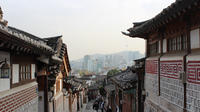The Best of Seoul - Private City Tour Including Nanta Show
Seoul, South Korea
Trip Type: Private Sightseeing Tours
Duration: 10 hours
This 10-hour private tour combines all the highlights of Seoul, including a viewing of the famed Cookin' Nanta performance.
More About This Activity All Private Sightseeing Tours →
This 10-hour private tour combines all the highlights of Seoul, including a viewing of the famed Cookin' Nanta performance.Your full day tour starts with a pick-up from your hotel at 9am with the following itinerary:
Royal Guard Changing Ceremony
During the Joseon Dynasty, the royal guards performed the given task by guarding the Gwanghwamun Gate, the entrance of Gyeongbokgung Palace where the king ruled the country. Since 1469, the ceremony has taken place and its record has been consulted for the present reenactment ceremony.
Gyeongbokgung Palace
Built in 1395, Gyeongbokgung Palace is also commonly referred to as the “Northern Palace” because its location is furthest north compared to the neighboring palaces of Changdeokgung (Eastern Palace) and Gyeongheegung (Western Palace). Gyeongbokgung is arguably the most beautiful and remains the largest of all five palaces, with beautiful buildings and pavilions.
Presidential Blue House
The signature markings of the Presidential Residence of Cheong Wa Dae are its blue tiles. It is the first thing that catches one’s attention upon entering the premises. The blue tiles and the smooth roof blend beautifully with Mt. Bugaksan in the backdrop.
Bukchon Hanok Village
Bukchon Hanok Village sits between the two palaces of the Joseon Dynasty, Gyeongbokgung and Changdeokgung, as well as the Jongmyo Shrine. Unlike other Hanok villages, Bukchon was not created for tourists but is actually a living village inhabited by Seoulites. The village is home to hundreds of traditional houses called ‘Hanok’ that date back to the Joseon dynasty. Today, many of these hanoks operate as cultural centers, guesthouses, restaurants and tea houses, providing an opportunity to experience, learn and immerse in Korean traditional culture.
Lunch
Insadong
Insa-dong, located in the heart of the city, is an important place where old but precious and traditional goods are on display.
N Seoul Tower
The N Tower, a complex culture space in Seoul, is where the clouds seem to meet with Namsan Mountain. The tower was built in 1969 on the highest point of Seoul so that visitors can enjoy the best panoramic views of the city. It was originally Korea’s first radio wave tower but has then been opened to the public in 1980, becoming a popular tourist attraction and a resting place for citizens.
Nanta Performance
Nanta performances, which are based on the rhythm of the samulnori (traditional Korean percussion quartet) and are comic non-verbal plays set in a kitchen. This shows have been so successful that they now run at three exclusive theaters in Seoul which are equipped with special lighting and sound systems to create maximum audience impact. Around 380,000 international tourists visit Nanta Theater every year.
Royal Guard Changing Ceremony
During the Joseon Dynasty, the royal guards performed the given task by guarding the Gwanghwamun Gate, the entrance of Gyeongbokgung Palace where the king ruled the country. Since 1469, the ceremony has taken place and its record has been consulted for the present reenactment ceremony.
Gyeongbokgung Palace
Built in 1395, Gyeongbokgung Palace is also commonly referred to as the “Northern Palace” because its location is furthest north compared to the neighboring palaces of Changdeokgung (Eastern Palace) and Gyeongheegung (Western Palace). Gyeongbokgung is arguably the most beautiful and remains the largest of all five palaces, with beautiful buildings and pavilions.
Presidential Blue House
The signature markings of the Presidential Residence of Cheong Wa Dae are its blue tiles. It is the first thing that catches one’s attention upon entering the premises. The blue tiles and the smooth roof blend beautifully with Mt. Bugaksan in the backdrop.
Bukchon Hanok Village
Bukchon Hanok Village sits between the two palaces of the Joseon Dynasty, Gyeongbokgung and Changdeokgung, as well as the Jongmyo Shrine. Unlike other Hanok villages, Bukchon was not created for tourists but is actually a living village inhabited by Seoulites. The village is home to hundreds of traditional houses called ‘Hanok’ that date back to the Joseon dynasty. Today, many of these hanoks operate as cultural centers, guesthouses, restaurants and tea houses, providing an opportunity to experience, learn and immerse in Korean traditional culture.
Lunch
Insadong
Insa-dong, located in the heart of the city, is an important place where old but precious and traditional goods are on display.
N Seoul Tower
The N Tower, a complex culture space in Seoul, is where the clouds seem to meet with Namsan Mountain. The tower was built in 1969 on the highest point of Seoul so that visitors can enjoy the best panoramic views of the city. It was originally Korea’s first radio wave tower but has then been opened to the public in 1980, becoming a popular tourist attraction and a resting place for citizens.
Nanta Performance
Nanta performances, which are based on the rhythm of the samulnori (traditional Korean percussion quartet) and are comic non-verbal plays set in a kitchen. This shows have been so successful that they now run at three exclusive theaters in Seoul which are equipped with special lighting and sound systems to create maximum audience impact. Around 380,000 international tourists visit Nanta Theater every year.
« Go Back

